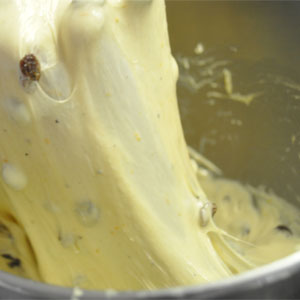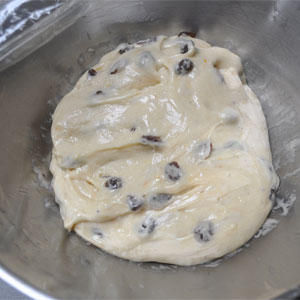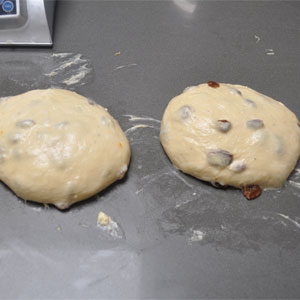Kulich
Traditional Orthodox Easter cake

One of the best things about Easter is being in the kitchen - and this recipe will keep you in there for a few hours!
Kulich - it's a traditional sweet bread made from a natural yeast starter, eaten at Easter time in lots of Orthodox countries in Europe.
The technique below is an off-shot of my Italian Panettone recipe, which is a bit of a killer to get right (even after 10 attempts). It's worth it though, so I hope you'll give it a try.
Makes 2 individual cakes
Ingredients
For the sponge
- 230g double zero flour (Marino "Soffiata" or Shipton Mill's Cibata)
- 126g water
- 1g Osmotolerant yeast (Saf Gold)
- 55g caster sugar
- 37g egg yolk
- 4g diastatic malt flour
- 55g unsalted butter
- 57g white starter at 100% hydration
For the final mix
- 55g double zero flour (Marino "Soffiata" or Shipton Mill's Cibata)
- 3g salt
- 17g egg yolk
- 45g water
- 10g dark rum
- 15g sour cream
- 55g caster sugar
- 84g unsalted butter
- 12g honey
- 84g raisins
- 4 cardamom pods, crushed and seeds removed
For the eggwash
- 1 large egg
- 2 tablespoons of milk
For the icing
- 500g icing sugar
- 1 teaspoon of almond essence
- Warm water as required
- Hundreds and thousands
Equipment
- Panettone cases
- Stand mixer
A couple of days before you want to bake, feed your starter to get it to maximum activity.
Mix the sponge
Mix all the sponge ingredients together in a bowl so that they are just combined. Cover with cling film, then leave to proof for 12 hours at 25℃. If you have a proofing box, that will really help regulate the temperature.
Mix the final dough

Start by placing the sponge in the bowl of your stand mixer and attach the dough hook. Add the flour, salt, egg yolk and 1/2 of the water. Turn your mixer to a slow speed for a few seconds until combined, then push up to a medium speed and mix for a further 5 minutes.
Next, add the sugar in 4 increments while the mixer is running with a 2 minute gap between each addition.
By now the dough has been mixing for 13 to 14 minutes. Change the speed to low, and add the butter a few pieces at a time. If your butter is a bit cold, just squeeze each piece with your fingers before dropping in. Continue mixing until all the butter has been incorporated.
 Mix the remaining water with the honey, rum and sour cream, then combine with the dough - again while the motor is still running.
Mix the remaining water with the honey, rum and sour cream, then combine with the dough - again while the motor is still running.
Finally, add the raisins and the cardamom and let them distribute evenly for a few seconds.
At this point you should have an extremely soft dough - stop the mixer to check it; you should be able to pull the dough back and get a window-pane effect as shown in the picture to the right.
If the dough hasn't quite developed, knead for a few minutes more until it cleanly pulls away from the sides of the bowl. Finally, transfer the dough to an oiled bowl and cover with cling film.
Bulk fermentation & bake
 Place your bowl in a warm place, 33 to 36℃ centigrade is good. Again, a proofing box comes in handy to regulate the temperature.
Place your bowl in a warm place, 33 to 36℃ centigrade is good. Again, a proofing box comes in handy to regulate the temperature.
Let the dough rise for 20 minutes, then perform 10 stretch and folds on the dough while in the bowl. Cover it again then repeat this a second time after another 20 minutes have passed.
 After another 20 minutes, perform the final 10 stretch and folds. Weigh the dough, and split into two equal amounts. Shape each piece into a tight ball, cover with oiled cling and leave on your work surface for another 20 minutes.
After another 20 minutes, perform the final 10 stretch and folds. Weigh the dough, and split into two equal amounts. Shape each piece into a tight ball, cover with oiled cling and leave on your work surface for another 20 minutes.
 Next, prepare your panettone cases by cutting 4 holes in each one, then placing a skewer or chopstick through each pair of holes.
Next, prepare your panettone cases by cutting 4 holes in each one, then placing a skewer or chopstick through each pair of holes.
Place one piece of the dough in each case, then put them back into a warm place again. This time, leave for about 4 hours so that the dough reaches near the top of each case. We're not making Panattone here, and we don't want a massively rounded top - so don't take it too far. The dough does rise slowly, so you need a bit of patience; once it's nearly there pre-heat your oven to 175℃. If you've got a baking stone, put it in to pre-heat as well.
The risen dough is really soft at this point, so gently eggwash the tops of each one. Finally, transfer to the oven and bake for 35 minutes.
While the cakes are baking, and while trying not to sound like you're undertaking a science experiment or being an executioner; prepare your hanging apparatus. You can use two broom handles over the back of two chairs - but my preferred method is to use two pieces of cardboard from wine / alcohol packaging, the kind that slot together. If you make a right angle with these, that should just about give you enough room hang the cakes.
When the 35 minutes are up, remove the cakes from the oven and immediately invert them. Balance the chopsticks or skewers over the cardboard or your broom handles so that they hare hanging upside down. Leave to cool completely - a few hours or overnight
Decorate
Mix the icing sugar with the almond essence and water. Take it to a pouring consistency - thin enough to pour, but thick enough to set.
Now that the cakes have cooled you've got two choices for icing - do what I've done, which is to ice the top and then remove the paper so that you get a clean line or, the more traditional way, remove the paper case, then let the icing drip down the sides of the cake.
Sprinkle over some hundreds and thousands before the icing sets completely. You're supposed to have it blessed by a priest before eating; but if you don't have one of those handy, then just cut and serve.
comments powered by Disqus









